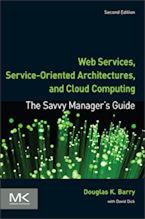Using the Data
There are three options for using the data in this example relational database. They are:
- Leaving the Data in the Relational Database
- Converting the Data and Storing It in an Object Database
- Leaving the data in the relational database and using an object database
Leaving the data in the relational database. Also see the related content below.
More Detail on Using the Data
Context for Using the Data
Related Articles for Using the Data
- Type Codes
- Using Type Codes to Construct Classes
- Multi-Type Views
- Checking the Class Hierarchy
- Adding Method Code
Author
Douglas K Barry
Principal
You may use this material for your work or classes. Reprint Policy. Be sure to check the menu at the left for other articles available on this site.
The Savvy Manager's Guide
Douglas K Barry is also the author of a book that explains Web Services, service-oriented architecture, and Cloud Computing in an easy-to-understand, non-technical manner.
Web Services, Service-Oriented Architectures, and Cloud Computing: The Savvy Manager's Guide (Second Edition)
by Douglas K Barry with David Dick
This is a guide for the savvy manager who wants to capitalize on the wave of change that is occurring with Web Services, service-oriented architecture, and—more recently—Cloud Computing. The changes wrought by these technologies will require both a basic grasp of the technologies and an effective way to deal with how these changes will affect the people who build and use the systems in our organizations. This book covers both issues. Managers at all levels of all organizations must be aware of both the changes that we are now seeing and ways to deal with issues created by those changes.

